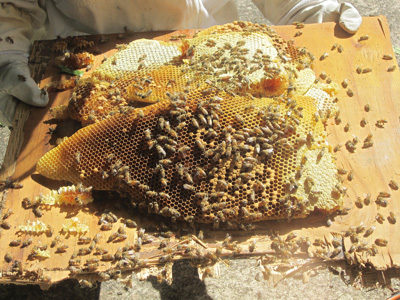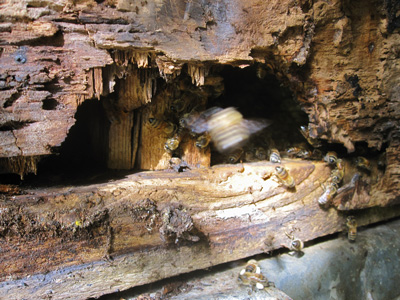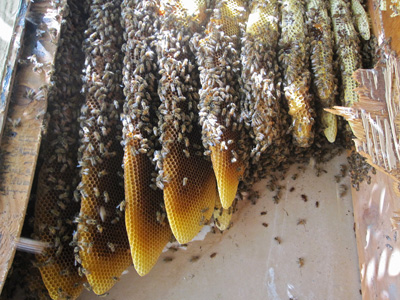We’ve been hearing a lot about honeybees dying en masse, about Colony Collapse Disorder, even predictions that the honeybee is headed for extinction. There is no doubt that beekeepers as well as farmers who require bees to pollinate their crops are losing lots of bees — entire hives in fact. Some beekeepers have reported that 30 to 90 percent of their bees have died.
It was while I was writing about how we can help save the bees by cultivating certain plants that I encountered a healthy, thriving colony of bees — inside my house. When I realized that they had built a hive right outside my bedroom, my first thought was not whether I should plant more firebush to provide them with more food.
I live in a wood-frame house, a Hurricane Andrew survivor, barely. There are benefits to a wood house: It’s easier to repair than concrete block for instance, but it also needs more repairs than concrete or brick would, particularly in the form of rotten wood. So, one shady corner of the house had a good amount of decayed wood trim, allowing a small area of access to inside the wall.
Foraging bees have always visited my yard; they seem to love my coconut palms’ flowers, as well as the firebush blooms. But this past spring my wife Ariel started noticing a whole lot of bees coming and going past our bedroom door, like golden streaks backlit by the sun. Where could they be going?
Towards sunset, when the bees begin to settle in, I found out. I spotted them around the wood trim at the very bottom of the wall outside our bedroom, the same corner with decayed trim. They had found an entrance, and were moving in, even removing the insulation bit by bit.
Each night we could lie in bed and hear them, and even heard the queen “piping.”
I am not a beekeeper, so I am learning as I go along. But I did know I didn’t want to kill the bees. What’s the point of pouring poison on everything? It almost never works out for the better.
I was tempted by the promise of a quick fix, I must admit. But if you kill a hive, it still needs to be removed quickly or it will attract roaches, ants and decay in general. Without the living bees to maintain things, honey will drip everywhere.
Though my family avoided the backyard, I frequently gardened there and the bees seemed to ignore me, never getting aggressive. Then one day, outside, I watched a honeybee land beside a droplet of water. I could see its proboscis contact the water — it was drinking! I couldn’t be its executor.
Since the decayed outer wall had to be replaced anyway, why not take the opportunity to remove the hive at the same time?
I looked for help and contacted an animal-saving exterminator, someone who removes pesky creatures without harming them. He told me the hive could be removed alive.

Combs on their way to relocation. They were placed in the shade of a tree across the yard, and after about three days, the angry bees dispersed. Photo: Lorelei Setzer.
It’s not always possible to remove without killing. If the hive were in a location where access was difficult or the bees were a direct danger to people, it might require extermination. But this hive was in easy reach.
Finally, eviction day came. The exterminator and I would work together.
Armored in beekeeping suits, we approached the hive entrance. I could estimate the location based on hearing the bee activity from inside the house. The wall also felt warmer in that area.
I pried the trim off first. Not much reaction from the bees. Then I used a power saw to cut into the wall, making certain I did not go deep enough to penetrate the interior drywall. That would be really bad. The vibrations certainly got the bees’ attention. Now they landed on us, though it’s not noticeable much with the protective face and headgear on.
By the time I finally pulled back the board to expose the actual hive, they were quite agitated.

Exposing the bees' access to the hive: decayed wood on a wall. Kenneth Setzer/FTBG.
The hive is truly a marvel. The wax combs were arranged parallel to each other, but at an angle to the framing, I assume to maximize ventilation and use of space. Each hexagonal cell was nearly perfectly formed to protect larvae, honey and pollen. I learned afterward that the substance the bees used to caulk space between the wood and drywall is propolis, resins the bees collect from trees and plants.
The odor upon exposing the hive is unpleasant and musky, but that soon gives way to the smell of beeswax and honey. The hive began a few feet up from the actual entrance. I imagine it was located to keep it high, dry and out of easy reach of predators.
We then gently scraped each honeycomb’s point of attachment to release it from the horizontal wood stud above, and carefully placed it onto a board. These were all placed in the shade of a tree across the yard.
I hadn’t found anyone to adopt the hive, so our hope was that they would disperse into a swarm and find a new location to create a hive. I sealed up the wall temporarily with roofing tarpaper until the angry bees dispersed, which they did in about three days.

The entire hive exposed: The wax combs were arranged parallel to each other, but at an angle to the framing. Kenneth Setzer/FTBG.
Straggler bees who were out foraging may return to find their hive gone, but nevertheless may try to re-enter the area, so be aware of this if you remove a beehive. Evicted bees are known to try and re-establish a hive in the same location; other swarms (a swarm is a homeless cluster of bees) may also try this, as they can smell the remaining wax and honey. Therefore, I scraped the area clean and wiped it down with a bleach solution before painting it with mildew-resistant paint.
Now I’m ready to replace the boards and wood with new material. Ah, home ownership!
If you observe bees gathering around an area of your home, watch to make sure they are not scouting the location for a possible hive. You may need to close off their access to walls, attics or other inside spots. It’s always a good idea to seal holes leading into or under your house, but keep in mind that bees can enter through a quarter-inch hole, so it’s impossible to seal up every crevice that size. Remember, bees do not burrow holes into wood — they enter only through an existing cavity.
If you do find a hive in your home, call a beekeeper, not the usual exterminator who would kill the hive rather than try to remove it. If you do need to kill the bees, you must remove the remains — including bees, wax and honey — to avoid some potentially destructive, nasty conditions. But please, try to have them removed by a professional, alive.
HAIKU FOR BEES
Beehive in my wall.
Golden bees, removed.
Now the bees are gone, missed
— KENNETH SETZER
